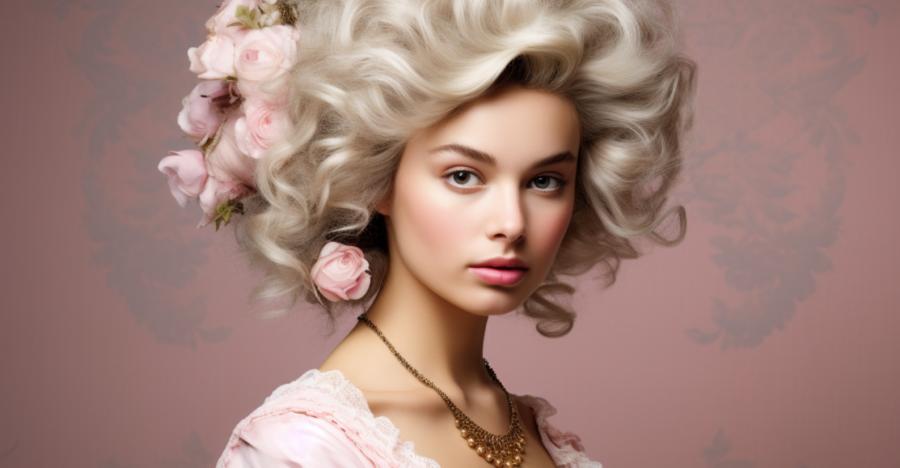Powdered Wigs Define 18th Century Parisian Elegance

A Brief History of Hair and Hierarchy
It was the best of times; it was the worst of times; it was the era of powdered wigs. In 18th century Paris, the powdered wig, or "perruque," was as much a symbol of elegance as it was a disease-ridden, lice-infested, pompadoured monstrosity. Unlike the relatively straightforward hairstyles of today, the perruque was a veritable tower of hair, held together by a sticky concoction of animal fat and flour, piled high to make its wearer stand taller and grander than their fellow Parisians. Equal parts ridiculous and fashionable, the powdered wig was the epitome of Parisian elegance.Wigs as Status Symbols
In a time when social status was of the utmost importance, powdered wigs became a way to literally rise above one's peers and display one's wealth and power. The larger and more elaborate the wig, the more affluent and important the wearer was perceived to be. They were worn by nobility, courtiers, and other members of the upper crust, and the perruque became so synonymous with power and influence that the term "bigwig" was coined to describe someone of significant stature.Wigs as a Practical Solution
Though they may have been a symbol of luxury and influence, powdered wigs also served a practical purpose. At the time, personal hygiene was not what we would consider… well, hygienic. The streets were teeming with filth, disease was rampant, and bathing was a rare luxury. As a result, hair could easily become infested with lice, and a shaved head was often the most effective way to combat the problem. The perruque, then, was a way to maintain an appearance of refinement and social standing while concealing a rather unglamorous reality.From Pompadour to Rat's Nest: Creating the Perfect Perruque
Constructing a powdered wig was no small feat. It began with the creation of a "cage," a wire frame that would serve as the foundation for the towering mass of hair. The cage was then covered with a fine mesh fabric, into which the wearer's own hair, or sometimes a cheaper alternative like horsehair or goat hair, was woven. To create the signature "pompadour" look, the hair was then teased and backcombed, creating volume and height. Finally, the entire creation was coated with a mixture of flour and animal fat, creating a white, powdery appearance and a scent that was, in a word, pungent.
Wigs, Politics, and the French Revolution
By the late 18th century, powdered wigs were beginning to fall out of fashion. Some attribute this to a shift in aesthetics, as simpler, more natural hairstyles began to emerge. However, there were also political factors at play. As tensions between the classes escalated and the French Revolution loomed, symbols of aristocracy and excess, like the powdered wig, became increasingly unpopular. Wearing a towering perruque was seen as an act of frivolity and self-indulgence, and it became a dangerous statement to make in a time of social turmoil.A Modern Resurgence?
Today, powdered wigs may seem like a relic of a bygone era, a strange and amusing footnote in the annals of fashion history. However, in recent years, the perruque has been enjoying something of a renaissance. In 2006, Marie Antoinette, a film directed by Sofia Coppola and starring Kirsten Dunst, brought the opulent world of 18th century Versailles to the big screen, complete with towering, pastel-colored wigs. The film's surreal, candy-coated aesthetic struck a chord with audiences, and suddenly, powdered wigs were back in the spotlight.Since then, the perruque has made appearances in high-fashion editorials and on the runways of avant-garde designers like Alexander McQueen and Vivienne Westwood. Contemporary interpretations of the perruque may not be quite as grand or lice-ridden as their 18th-century counterparts, but they are a testament to the strange and enduring appeal of this symbol of Parisian elegance.
Conclusion
From the extravagant courts of Versailles to the gritty streets of revolutionary Paris, the powdered wig has seen its share of highs and lows. Though it may have been a symbol of elegance, wealth, and power, the perruque was also a practical solution for a society plagued by disease and poor hygiene. Today, the powdered wig continues to fascinate and inspire, even as it reminds us of the absurdity and excess of a bygone era. In the immortal words of Marie Antoinette, "Let them wear wigs!"Article kindly provided by foreverinfashion.org
Latest Articles
- Style That Works With Your Body, Not Against It
- Fashion Tourism on Wheels: Curated Shopping Routes Led by Chauffeur Guides
- The Charm of Certainty in a World of Indecision
- Can an Everyday T-Shirt Be Turned into a Modern Heirloom?
- Color, Ceremony, and the Psychology of Celebration
- Styling Graphic T-Shirts for Different Body Types
- Getting Kids to Wear Their Hats Without a Bribe or a Meltdown
- Mastering the Art of Being the Unnoticed Photographer
- Quiet Sportswear Moves Loudly
- Fashion's Most Misunderstood Color Is Brown
- Weight Matters When Cotton Gets Real
- SKU's Out for Summer: Why Your Warehouse Is Melting Down
- Ink as Accessory - How Tattoos Are Replacing Jewelry in Modern Style
- Decoding the Y2K Aesthetic with Style and Sanity
- Accessories
- Jewellery
- Footwear
- Skirts and Dresses
- Shirts and Blouses
- Beauty and Makeup
- Fashion Photography
- Sustainable Fashion
- Street Style
- Fashion History
- Fashion Business
- Fashion Styling
- Fashion Events
- Plus-Size Fashion
- Men's Fashion
- Women's Fashion
- Fashion Blogging
- Fashion Trends
- Fashion Retailers
- Fashion Tips and Advice
- Fashion Business Startups
- Fashion Around the World
- Lingerie
- Sportswear
- Weddings

